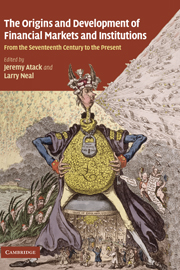 The Origins and Development of Financial Markets and Institutions
The Origins and Development of Financial Markets and Institutions Published online by Cambridge University Press: 04 August 2010
The years between the two World Wars were ones of economic turmoil and crisis. The inter-war gold standard, created as an attempt to rebuild the pre-1914 gold standard, lasted a mere six years from 1925–1931 and failed to generate economic growth and prosperity. Many scholars have attempted to explain the fragility of the inter-war gold standard, focusing on different aspects of the regime, such as structural problems within the system, gold imbalances, the lack of an international hegemonic power, persistent deflation, and the changing social and political structures in the inter-war years. One particular area of focus with regard to the operation of the system has also been the study of central banks within the system. Did they play by the rules of the game, supporting the international monetary regime with interest rate adjustment, or were their policies guided by domestic constraints and objectives?
This chapter sheds new light on the central bank reaction functions of four countries on the periphery, namely Austria, Czechoslovakia, Hungary, and Poland, by exploiting a natural experiment that was run throughout the inter-war years in eastern Central Europe. The four selected countries constitute an interesting mix of different institutions, as shown in Table 13.1. In Austria and Hungary the central banks were reconstituted under the auspices of the League of Nations to import credibility and establish stability following the hyperinflations of the early 1920s. Czechoslovakia and Poland in contrast, created monetary authorities without any external control.
To save this book to your Kindle, first ensure no-reply@cambridge.org is added to your Approved Personal Document E-mail List under your Personal Document Settings on the Manage Your Content and Devices page of your Amazon account. Then enter the ‘name’ part of your Kindle email address below. Find out more about saving to your Kindle.
Note you can select to save to either the @free.kindle.com or @kindle.com variations. ‘@free.kindle.com’ emails are free but can only be saved to your device when it is connected to wi-fi. ‘@kindle.com’ emails can be delivered even when you are not connected to wi-fi, but note that service fees apply.
Find out more about the Kindle Personal Document Service.
To save content items to your account, please confirm that you agree to abide by our usage policies. If this is the first time you use this feature, you will be asked to authorise Cambridge Core to connect with your account. Find out more about saving content to Dropbox.
To save content items to your account, please confirm that you agree to abide by our usage policies. If this is the first time you use this feature, you will be asked to authorise Cambridge Core to connect with your account. Find out more about saving content to Google Drive.